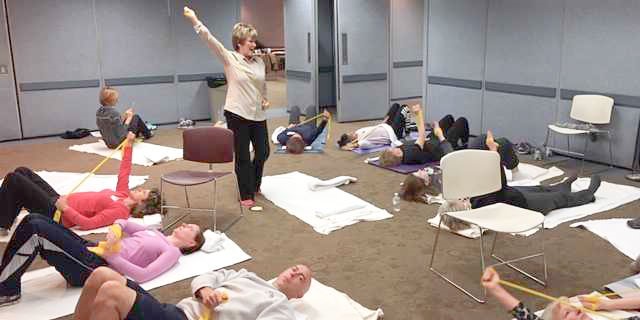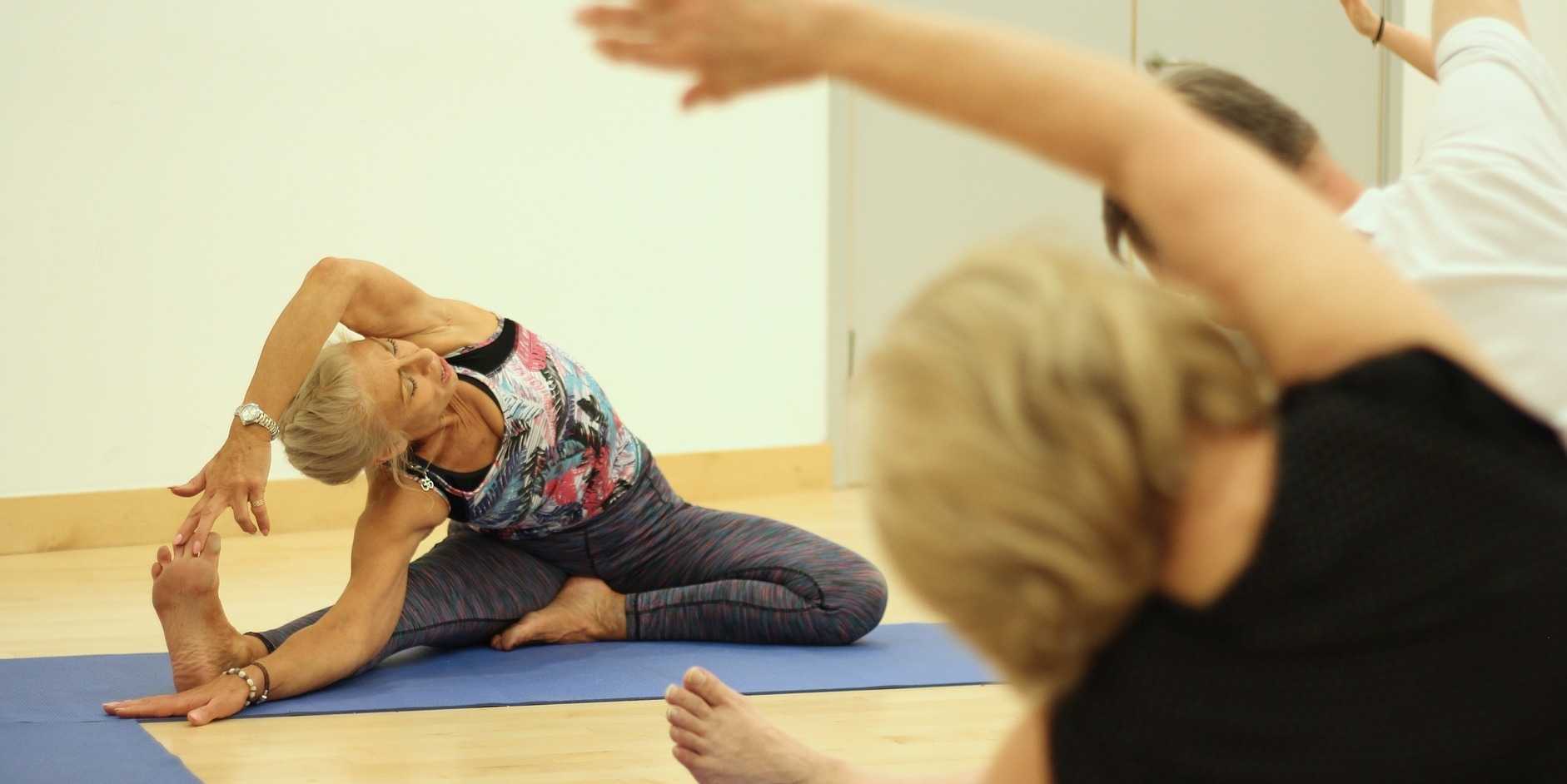The National Association for Continence (NAFC) has recently created a press release naming the Women's Pelvic Health & Continence Center and the Woman's Hospital of Texas a "Center of Excellence (COE): Continence Care in Women." The release highlights the fact that this is the first time a community hospital as well as a private group of physicians have been given this award. A healthcare institution that meets the pre-qualification requirements can apply and then independently collected patient satisfaction data, a site visit, and employee interviews make up part of the rigorous process that can, upon award of the COE designation, help patients find centers of care that the NAFC can stand behind and promote.
Fatima Hakeem, physical therapist and director at Woman's Hospital of Texas, has created the foundation for program development and excellence at her facility which won this prestigious designation. Many of you may know Fatima as an educator, mentor, author, or by the work that she has created for marketing and developing the business of physical therapy. Her advice towards developing a women's health practice was featured in the physical therapy magazine "Advance" in 2005, click here to read the article. She has authored various publications related to the practice of women's health physical therapy, including chapters in Irion and Irion's Women's Health in Physical Therapy. Fatima's accomplishments are many, and you can learn more about the steps on her journey by visiting her website: fatimahakeem.com.
Fatima, along with Holly Herman, founding faculty of the Institute, made an epic journey to Saudi Arabia where they took on an 11 day comprehensive women's health training of more than 30 women. (Click here to see the blog post about that trip!) Both educators and the Institute were honored by the Princess herself. Their next travels will be to Dubai later this year, keep an eye out for a blog update about the upcoming trip and learn where the Institute and esteemed educators such as Fatima and Holly will be sharing their wealth of knowledge. There are many women who have paved the way for the growing numbers of pelvic rehabilitation providers, and through tremendous efforts and acts of generosity they have and will continue to provide opportunities for therapists in this country and abroad. Opportunities to offer support and skilled care for other women and men who so desperately need to hear that their conditions can be alleviated or improved. Hats off to Fatima for her dedication to the profession and to her facility, which is now celebrating a "Center of Excellence" award!
The prevalence of urinary incontinence in women who have multiple sclerosis (MS) is dramatic, according to research recently published in the International Neurourology Journal. The authors conducted the study within a treatment center that is dedicated to the care of patients with MS. Out of the 143 women surveyed, stress UI occurs in 55.9%, urge symptoms in 70.6%, and 44.8% had both stress and urge symptoms, also known as mixed incontinence. The authors report that the condition of UI significantly impacts quality of life (QOL.) The Urogenital Distress Inventory (UDI-6) and the Incontinence Impact Questionnaire (IIQ-7) were utilized to collect data about both stress and urge urinary symptoms and QOL impact. Women in the study ranged in age from 20-72 years of age, and the subjects who reported stress urinary incontinence were older and tended towards a higher body mass index (BMI). The women with complaints of stress UI also scored higher on the Incontinence Impact outcomes survey as it related to physical activity. This article is available for free in full-text format by clicking here.
One of the challenges for the patients who have MS and for the providers who work with them is the potential fluctuation in symptoms. This chronic neurologic disease is characterized by "flare-ups" that usually require a period of medical intervention followed by a time of recovery in which the patient often has to gradually return to prior levels of function. Neurologic lesions of MS can occur in varied levels of the nervous system, thereby influencing the neurologic control of the urinary system to a varying extent. If a patient is going through a flare-up it may be best to limit the amount of intervention such as strengthening of pelvic muscles until the exacerbation has eased. Some patients are fortunate to experience periods of relative stability in symptoms, even so, fatigue and the risk of increasing fatigue through overactivity is significant. During your subjective history taking, you can inquire of the patient how the disease has tended to manifest for him or her, and then inquire about stability of symptoms and the patient's warning signs for fatigue. It is also important to screen for signs of a urinary tract infection (UTI), as UTI's frequently occur in this patient population. Regarding objective examination, it is imperative to assess the patient's current level of pelvic muscle awareness, strength, sensation, coordination, and endurance. The patient may return for another bout of care at a different time and present with very significant differences in level of function, therefore it is not safe to assume that the patient has a similar baseline to the last bout of therapy.
In my clinical experience, patients who have MS often experience both urge and stress symptoms. For clarification of this terminology, please click here. Utilization of electrical stimulation for either strengthening or neuromodulation of urge symptoms can be a useful adjunct to education and home program management. You can use the knowledge that you have regarding application of electrical stimulation for any patient population, with the consideration that significant fatigue should be avoided. This requires that your exercise prescription skills are applied carefully to the patient's current level of strength and endurance, with close follow-up prior to any increase in home program strengthening. An earlier study by McClurg et al. (2008) suggested that electrical stimulation in addition to pelvic muscle training and biofeedback should be offered as a first-line treatment for lower urinary tract dysfunction in MS. Sacral nerve stimulation is also an option that your patient may have utilized or is interested in discussing. Information about sacral nerve stimulation can be found here. The National MS Society in the US has a clinical bulletin published regarding many medical topics for both health care professionals and patients. The bulletin regarding urinary incontinence can be accessed here, and although it does not discuss the use of rehabilitation, there is a useful algorithm that medical providers are utilizing for the treatment of UI, and the bulletin also emphasizes that early referral to an urologist is important. The study referenced in the first paragraph of this posting points out that the majority of patients in their study were consulting with a neurologist, but not a urologist. It is also significant to remember that urinary symptoms may be one of the first signs of a neurologic disease or condition, and that medical evaluation must be completed prior to rehabilitation commencing so that conditions may be identified and treated early in the process.
As many of you know, the Herman & Wallace Pelvic Rehabilitation Institute is currently developing a Pelvic Therapy Practitioner Certification process (PTPC). As part of the multi-step process involved in the development of a robust certification, the job task analysis survey was completed by more than four hundred providers (403 to be exact.) The Institute was thrilled that so many current, past, or future course participants believe in this process so strongly that even a seemingly endless survey could not deter you from completing the tedious, yet crucial questions that were posed. In another step of the process that occurred after the results of the survey were tallied, I was able to view the tables of responses and I found the information very interesting- I thought that you might also be interested to know a bit more about the answers that we received in the survey.
Keeping in mind that the pelvic rehabilitation specialty is one that is not as well-represented in the clinic as orthopedics, for example, and yet is a specialty that is gaining in popularity, it was interesting to note that nearly 1 in 5 therapists completing the survey had less than one year of experience working in pelvic rehabilitation. Approximately 82% of the more than 400 people completing the questions has been working within pelvic rehabilitation for 10 years or less. In terms of the education of the people represented, the highest degree earned at the time of the survey was a doctorate for 41.4% of people, with 8.4% of those represented by transitional doctorate degrees, and less than 1% by an academic doctorate.
Several people indicated that they had board certifications in either cardiovascular and pulmonary (2), geriatrics (2), neurology (1), pediatrics (1), sports (3), and orthopedics (23), or women's health (17). Other qualifications listed by those completing the survey included LANA certification for lymphedema therapy, manual therapy certifications, yoga, Pilates, and biofeedback certifications, to name a few that appeared frequently.
Geographically, most were from the United States, with the addition of 7 Canadians and 4 "Other." The states in the US most represented included California, with 54 people holding a license in that state, followed by Washington (38), New York (30), Illinois (27), and Florida (22).Employment status for the most part was reported as full-time salaried (55%), and part-time salaried (29%). Just over 13% of those responding reported that they were either full-time or part-time self-employed. Only 5% reported spending 50-100% of working hours in an acute care hospital setting, with approximately 3.5% working in acute care setting 90-100% of the time. 1 out of 3 respondents work exclusively in a health system or hospital-based outpatient setting, and an additional 1 of 3 people work in a private practice setting. Other work environments such as home care or rehabilitation hospital made up a very small percentage of work settings reported. Direct patient care constituted 71-100% of the workload for 92.1% of the group, and nearly 3/4 of the respondents reported spending 0% of his or her time completing administration. Nearly 90% answered "0" for percentage of time spent on research, and the most amount of time indicated for research (by one person) was 20%.
When addressing pelvic rehabilitation specifically, here is an approximate breakdown of time spent in treatment:
% time in pelvic rehab % of respondents
| 0-3% | 7.2 |
| 5-10% | 14.4 |
| 15-30% | 20.6 |
| 30-50% | 21.3 |
| 55-75% | 16 |
| 80-90% | 15.3 |
| 94-100% | 10.3 |
74% reported never working with children ages 12 and younger, and 34% reported never working with adolescents 13-20 years of age. Other age groups were fairly evenly represented. In terms of how many therapist treat male patients, let's look at another breakdown.
Male patients treated % of respondents
| 0-3% | 11.6 |
| 5-10% | 13.1 |
| 15-30% | 28.2 |
| 35-50% | 42.9 |
| 55-70% | 3.4 |
| 80% | 2 (1 person) |
| 100% | 2 (1 person) |
When we look at how the survey collected information about diagnoses, nearly 98% of respondents reported treating pelvic organ prolapse or fecal incontinence 0-20% of the time, whereas pelvic pain and urinary incontinence occurred more frequently as a condition treated. Many therapists listed general orthopedic conditions as appearing the most frequently on the caseload. Referral sources or providers who send patients for services include family practice, obstetrician/gynecologists, physician assistants, nurse practitioners, urologists, chiropractors, other physical therapists, sex therapists, psychologists, midwives, acupuncturists, yoga instructors, naturopaths, "the internet", former patients, and massage therapists.
One question on the survey asked "what motivated you to enter the pelvic rehabilitation field?" Of the 396 people who answered this optional question, almost 1 of every 4 chose "personal history or family history" as the reason. 40% chose "practice or clinic need" which certainly corresponds to what we hear at live courses. Very often we are told that a therapist who usually treated the pelvic rehabilitation population went on leave or moved, and so the clinic needed to train another therapist. Many therapists wrote in comments about how they wanted to serve a population with true need, or help restore quality of life. Salaries ranged from $25,000 or less (2.5%), $25,000-$50,000 (12.4%), $50,000-$75,000 (44.9%), $75,000-$100-000 (26.3%), $100-$125,000 (3.2%), $125,000-$150,000 (1.2%), and $150,000 and higher (1%). Of the 403 who completed the survey, 8 were men.
389 of those who completed the survey also indicated ethnic origin. Results indicated that 86.1% are Caucasian, 4.5% Asian or Pacific Islander, and 1.5% Hispanic, 1% Filipino, with less than 1% indicating African American, Native American, or Other (included Asian Indian, Caribbean, Eurasian, Latino non-Hispanic, Latino American, and Middle East represented as write-in options.) Reported ages included 21.5% being age 30 or younger, nearly 40% in the category of 31-40 years of age, 23% ages 41-50, 14% 51-60 years, and the remaining approximately 2-3% in the category of 61-74 years of age.
We want to keep in mind that this is a sample of primarily physical therapists who, for the most part, are currently involved in treating at some level patients who have pelvic dysfunction. It appears that many of those who responded are working in outpatient, orthopedic settings, nearly all respondents are female, and most are Caucasian. If I were to go so far as make recommendations or state hopes for the results of future surveys, it would be that more pelvic rehabilitation providers offer a solid representation of the various ethnicities which also make up our patient populations, that more male therapists are treating patients with pelvic rehabilitation needs, and that we find pelvic rehabilitation providers working in a wide variety of settings, with more pediatric patients and with more male patients, so that we can catch the dysfunctions early on in a patient's life, and so that men and women have more of an equal chance at healthy pelvic function. Thank you to Kriterion for providing such detailed and interesting data, to the Herman & Wallace Pelvic Rehabilitation Institute for investing in this endeavor towards a pelvic therapy certification, and mostly, to all of the participants in this survey who provided thoughtful replies so that we can generate meaningful data and most importantly, so that we can move forward in this process of recognizing those who strive to be excellent pelvic rehabilitation providers.
Hopefully you are enjoying the heat of August, and staying cool while we enjoy record breaking heat in many states. This time of the summer is often when we feel the panic of the season slipping away, preparing to enter into the fall season of back-to-school and changing our wardrobes. It may seem slightly out of season, then, to discuss handwarming at a time when most of our hands are staying pretty toasty, but it is such a simple, tangible, and effective clinical tool that it is worthy of a blog post. Hand warming, also described as temperature biofeedback, is a form of self-regulation that allows a small probe to be heated, or warmed, by the skin temperature. Recall that biofeedback is a broad term that describes an approach in which a subject is given some type of information, perhaps in the form of an audio or visual signal, which is related to the subject's physiologic response to an intervention or experience.
According to the very thorough textbook "Biofeedback: A Practitioner's Guide" by Mark Schwartz and Frank Andrasik (3rd edition), the measurement of changing skin temperature is meaningful because sympathetic arousal is correlated to vasoconstriction. When the nervous system is calmed, and the blood vessels dilate, more heat is allowed into the local vessels thereby increasing local temperature. I was first introduced to the clinical tool of "handwarming" using a thermistor by Janet Hulme who taught a wonderful course on the topic of fibromyalgia. On her website she offers a device called the PhysioQ for $25. That seems like the going rate for many of the devices on the market, including this "stress thermometer" sold by bio-medical.com. The bio-medical site also has a terrific page explaining the concept of handwarming as well as specific strategies to apply for teaching its use. Click here to access that page.
The instruction in the clinic of handwarming can be billed as part of your home program training. In this time of decreasing reimbursement and emphasis on self-care, a device such as a thermistor could be a perfect training tool for your patient who wants to continue to manage stress, tension, and to use handwarming as a part of his or her rehabilitation program. The great thing about devices that give feedback is the instant gratification and measure of success that a patient can achieve when the ability to monitor and influence physiologic measures is seen. A thermistor typically has a wire that terminates in a sensor that can be attached (with tape or a little piece of velcro) to the underside of a fingerpad. The readout is observed in degrees, and some devices will have the ability to set goals or use tones for audio feedback. The use of a thermistor has been documented in the literature for the treatment of Reynaud's syndrome, migraines, and other conditions that have a stress-related component.
Schwartz & Andrasik recommend considering the following to avoid "artifact" which can alter the accuracy of readings when using temperature biofeedback.
- A very cool room can also cool the sensor.
- A very hot room will affect the ability of the subject to reduce heat in the hands.
- When coming in from the cold, allow the hands to warm to room temperature first.
- Avoid placing a blanket or other item that will restrict air flow and affect the sensor.
I have seen several articles talking about the “Grey Effect.” The idea is that the incredibly popular book series beginning with “Fifty Shades of Grey” has created a frenzy of female sexual interest. (When I say “incredibly popular” the series has allegedly outsold the paperback Harry Potter series…) I won't go into detail about the book, or about the various critiques and controversies, let's save that for the people who are well-poised to do so. In a nutshell, the book series contains “explicitly erotic scenes.” Reports suggest that the book series craze is sending women in droves to the sex toy shops and is giving women permission to explore their sexuality. What does that have to do with pelvic rehabilitation?
The book may be a topic of discussion with our patients and this in itself may encourage us to explore our own comfort zones related to sexual health. How do you respond when a woman says that she has pelvic pain, is using a sex toy to stretch the vaginal opening, but her husband's penis is much bigger than the toy and she still has pain? How do you give advice about masturbation- or do you? What is the correct response to "my partner thinks I should be able to have an orgasm with penetration?" The replies to any of these questions depend on several factors, such as your level of knowledge about sexual health including anatomy and physiology, your own belief systems, the standards and culture at your place of work, as well as your understanding of sexual practices that are different from your own. What are the ethical issues that surface when faced with the above questions? If you are outside of your comfort zone and do not want to talk about sexual function, is it ok to say so, or are you denying your patient access to available information? How much do you share, knowing that these conversations are intimate and potentially confusing if your patient has poor boundaries? What if a patient asks you some questions and you are feeling unclear about the patient's motivations? These are really good topics for discussion, and outside of giving comprehensive answers, I would like to point out some ideas and resources that may be helpful to you. The Herman & Wallace Pelvic Rehabilitation Institute offers several courses that provide education about sexual health and function or dysfunction. All courses in the series discuss sexual function to some extent, and the Level 3 course has quite a bit of detail about sexual health. The Male course discusses rehabilitation of male sexual function, and there is a newer class instructed by Heather Howard, PhD, all about sexual interviewing and counseling.
It can be a challenge to navigate this territory as this type of “real-world” education rarely happens in school. First, we have to respect ourselves enough to take care of ourselves. This means that when you are not feeling very comfortable with the content of the conversation, say so. A statement such as “I'm not really comfortable with our conversation, let me think about your questions and come back to that next visit if that works for you.” This allows you to take the time to consult with a mentor, a supervisor, or a textbook if needed, or to process how you feel about the question so that you can give a more objective answer. If the patient is being inappropriate, such as asking for your phone number or saying anything suggestive, bring it up. “That is an inappropriate comment, and in order for you to continue to attend rehabilitation here, you must respect that.” If the inappropriate behavior continues, fire the patient, document it, contact the referring provider, and move on. If you are not really sure what sexual technique or act the patient is referring to, a phrase that can be helpful is “tell me more about that.” It is possible to discuss body mechanics in a respectful, professional manner even when discussing sexual health. It's not typically the way we are acculturated, so it takes practice and thoughtfulness.
When patients are interested in accessing websites for the purchase of devices to stretch, stimulate, or vibrate the pelvic muscles, the vendors listed on the hermanwallace.com website have ordering information for some commonly chosen devices. Other sites that are helpful for the patient are www.babeland.com or www.goodvibes.com. The American Association of Sexuality Educators Counselors and Therapists or AASECT website is also one that might be helpful for you as a provider or for your patient as a consumer. If you are looking for a certified sex therapist, that site also lists them by region. Most experienced therapists will tell you that as long as we stay open and listen well, it is our patients who will teach us as much as we can learn in any course or textbook. Optimizing our own comfort levels with sexuality can bring us closer to having meaningful dialog with our patients who trust us enough to inquire about such sensitive topics.
A colleague recently sent an inquiry through the Institute asking if there is new research supporting pelvic floor muscle training after radical prostatectomy. As a matter of fact, I chose not to report on some recent research that I read, because it does not support conservative care for urinary incontinence (UI). The Cochrane review for postprostatectomy UI was updated this year, and the results of the review indicate that we need more and better research. (If you are unfamiliar with the Cochrane library, one of its 6 databases contains systematic reviews of the literature that are updated periodically.) Although within the abstract of the reviewthe report states that there is a lack of consistency in the interventions, the populations, and in the outcome measures, the value of conservative approaches is deemed "uncertain." The authors do conclude that benefit from one-to-one pelvic floor muscle training is "unlikely" following transurethral resection of the prostate, or TURP.
The critiques of the research listed in the review include the above mentioned lack of consistency in outcomes and interventions. Most of the studies also did not include a report of pre-surgical outcome status, of adverse effects, and lifestyle changes as an intervention was never identified in any of the research. This leads us to this question: why are we treating men for UI or erectile dysfunction (ED) if this systematic review brings into question the efficacy of what we do? Certainly patients are improving as a result of pelvic rehabilitation, or I doubt that the medical providers would continue to refer patients to the offices who provide rehabilitation to these patients. What we do not know about each of the studies is how much of the male anatomy was affected by the procedure for the prostate. The patient's pre-surgical status and the skill level of the surgeon are both known factors for outcomes following prostatectomy, yet how are those quantified in the literature?
Most importantly, how can we be a part of the solution when it comes to creating research to support the services that we provide. It may be helpful as therapists to be certain that we are maximizing the level of knowledge about the surgeries, the anatomy involved, and about the available treatments. This can mean attending coursework that is specific to or includes discussion of male pelvic floor issues. (Check out the Pelvic Floor Series level 2A course or the Male Pelvic Floor Courses offered by the Institute, especially if more male patients are finding their way to your door.) Speak with referring physicians about surgical techniques, observe some surgeries, or attend a urology conference (maybe there's one near your hometown, or you want to attend with your local referring urology group.) Always document using outcomes studies when you can. Write a case study. You can even purchase a text book that teaches you step-by-step how to write a case study. I know that you don't have time...so, create a weekly lunch meeting at work with a colleague where you each work on and critique each other's project. Getting involved with local university programs can also allow you to be part of the research solution.
In summary, we need more and better research that documents how we are helping our patients. In relation to male patients following prostate procedures, who is screening these men to decide if they have tight, painful pelvic floor muscles versus weak muscles with lack of awareness of their use? We are the best chance the patient has in helping with the rehabilitation process. It is also imperative that we are testing muscle function in men to help categorize the patient as someone who might improve with an exercise-based approach or as someone who might need a trial of pelvic floor muscle electrical stimulation. If you tend to complete internal muscle testing with women, yet feel uncomfortable with this approach in men, I encourage you to move forward in your practice of this critical skill. We need to catch the patients early on who seem to have no muscle function and no awareness, and then refer that patient back to the surgeon within a reasonable time frame if there is a lack of progress. A few of the men I worked with who went on to have a male sling had very positive outcomes, and they also were very grateful that they had a pelvic rehabilitation provider to give guidance and feedback along the way. Patients who are more aware of their pelvic muscles, how to use them (and not use them!), and who know how to take care of their pelvic muscles throughout their lifespan are better poised to handle the post-surgical pathway if they should require further intervention.
What pelvic symptoms can vitamin D deficiency be causing in our pelvic rehab patients?
Vitamin D deficiency has been researched heavily in relationship to topics such as autism, fertility, multiple sclerosis, orthopedic health, muscular pain, osteoporosis, as well as pelvic floor health. Deficient levels of the vitamin have been reported as reaching "pandemic" levels, with risk factors including old age, dark skin, obesity, Chrohn's disease, occupations that require indoor activity, or living in cultures that require covering of face and body. The use of sunscreen to prevent UV exposure has also been linked to poor vitamin D levels as the sun is one way that we receive vitamin D.
Following is a brief list of research that has linked vitamin D to pelvic health issues:
- A study published this year reported that symptoms of dysmenorrhea were significantly reduced with administration of a single oral dose of vitamin D.
- Research regarding prostate cancer prevention is thought to be assisted by Vitamin D, with animal model research demonstrating protective effects, yet significant questions remain about the true effects in human populations.
- Vitamin D deficiency is associated with urinary incontinence in men in this national study, and also with other lower urinary tract symptoms.
- Higher vitamin D levels are reported in this research to be associated with a lower rate of pelvic floor disorders in women including urinary incontinence.
It is also important to be aware of comorbid conditions and current medications as both can lead to vitamin deficiency.According to the National Institute of Health's (NIH) Quick Fact sheet, medications that may interfere with vitamin D include corticosteroids, weight-loss drugs such as Alli, the cholesteral lowering drug cholestyramine, and some anti-epilepsy medications. The NIH has a more detailed fact sheet for health professionals that can be accessed here.While it may or may not be in your scope of practice to prescribe nutritional supplements, it is appropriate to share research reports and to inquire if the patient has had nutrient levels, such as vitamin D, checked by her physician. Further research may clarify the effects of low vitamin D levels in the body which are critical for healthy function.
The Agency for Healthcare Research and Quality (AHRQ) Julyfeature story is one of hope for improving care for women who suffer from issues of urinary incontinence or pelvic pain. The AHRQ publishes reviews of literature on various topics and then prepares documents for both the clinician and the consumer summarizing the findings of the research. Reviews pertaining to female urinary incontinence and female pelvic pain were updated this year, and the evidence, according the the summaries, is encouraging of pelvic rehabilitation therapies as opposed to medications and surgical approaches.
The AHRQ is the research arm of the US Department of Health and Human Services, looking at issues within health care quality, costs, outcomes, and patient safety. In preparing the evidence summary for urinary incontinence, 889 research articles were reviewed. The report states that 25% of young women, 44-57% of middle-aged and postmenopausal women, and 75% of older women in nursing homes report urinary incontinence (UI). Age, pregnancy, childbirth, menopause, hysterectomy, and obesity are all recognized as risk factors for UI, and when we consider how many women within our patient populations (or community populations) present with such risk factors, we can begin to understand the scope of the problem. The report notes that pelvic floor muscle training (PFMT) alone is as effective for stress and mixed UI as when adding biofeedback, bladder training, or electrical stimulation. For urgency UI, bladder training alone is as effective as bladder training with PMFT. Also according to the report, 19.5 billion dollars annually are spent for treatment of UI. To access the clinician summary regarding the non-surgical treatments for urinary incontinence, click here, for the patient summary, click here. The patient, or "consumer" file is also available in an audio version on the AHRQ website.
In the March 2012 research activity update, the AHRQ issued a statement that evidence is lacking to support surgery for pelvic pain. Based on the review of pelvic pain treatment options, there is a recommendation for further studies not only related to surgery, but also for conservative options for treating pelvic pain. In the comparative effectiveness review summary for patients, that can be accessed here, it is recognized that irritable bowel syndrome, endometriosis, painful bladder, tense pelvic floor muscles, or scar tissue can all create pelvic pain. It is also noted that a provider may refer a patient for physical therapy. In the clinician summary of the effectiveness review it is stated that there is not enough evidence to conclude that pelvic muscle therapy is effective for treating pelvic pain. This leads us to a common conclusion in health care: we need more clinical research that helps us answer questions about effective approaches for treating pelvic pain.
If you are interested in creating an opportunity to participate in clinical research, contact a local university physical therapy program to inquire about options. If you feel that you lacked training in research methods or concepts of evidence-based medicine, try taking a local or on-line course in one of the above topics. You do not need to be enrolled in any particular program to take a course, and you may even be able to audit a class if you contact a nearby educational facility.
The value of being aware of these documents created by the AHRQ is that we are often in a role of educating patients about treatment options. It is important that we represent the accuracy of the research as evaluated by government committees, and stay abreast of updates and additions to the body of knowledge. It is also helpful to direct patients to these websites when we know our patients are able to further empower their own lives by having more information.
On at least a weekly basis, most pelvic rehabilitation providers hear "I didn't know there was therapy for my condition." We also have to field questions about why the medical provider did not refer to rehabilitation before recommending surgery or drugs. One of the best ways for us to improve the lack of awareness in our communities is to go out and speak to them. While we have opportunities throughout our work and personal time to share information about what we do in practice, we can maximize the sharing of information by preparing a more formal option than simply giving our "elevator speech" from time to time.
A community presentation takes a little preparation and possibly a few tools. Fortunately there are many resources available for you to utilize when giving a talk to the public. Here is a look at what you might consider:
- The audience- to whom are you going to present information? Find out exactly who, how many, and what the goals of the audience is ahead of time. Showing up to give a talk about urinary incontinence when the group thinks you are speaking about arthritis could be awkward. It is also helpful to make sure there is enough space for those in attendance so you are not distracted by trying to add more chairs, move tables, etc.
- The topic- sometimes it is helpful to keep the topic broad, for example, "what does a pelvic rehabilitation provider do?" may be a generally interesting presentation. However, if you are speaking to a bladder pain/interstitial cystitis support group, you may want to me more specific in addressing bladder dysfunction and pain.
- The length- community members (and potential patients) want to ask questions. Inquire how much time you will have to speak, and then if there is time allowed for questions and answers. If there is not time allocated for answering questions, leave 10-15 minutes at the end of your presentation (and possibly plan to stick around a few minutes more if needed.)
- The presentation- unless you are speaking to medical residents or another professional group, skip the powerpoint. If you can bring a pelvic model, bring a prop like you may have seen an instructor use during a demonstration, or bring a chart or other visual aid, this may allow to you speak more naturally, tell a few stories. It also avoids the inconvenience of dealing with IT issues at the last minute.
- The giveaways- always bring with you some business cards and some brochures if you have them. Attendees will want to walk away with something tangible so they can contact you or tell a friend or loved one about your services. There are also sites that allow you to download and print handouts for patients. National sites such as the NIDDK have patient information about urinary incontinence in men or women (click on either word to access the document) and you can see that the handout is not copyrighted. You will also see that the handout is available in both Spanish and English versions. Other giveaways might include a water bottle, a stress-ball to squeeze, or a pen with your clinic name on it.
- Where to present- the options are endless, especially if you are willing to be creative and think outside of the doctor's office. Check with your local health clubs, they often allow presenters to come in and share information. Assisted care facilities are used to organizing activities for residents, and local hospitals may allow you to speak. Look on your newspaper community activity page or hospital website and see what support groups are meeting- perhaps a prostate cancer group, bladder pain group, fibromyalgia group, pregnancy class. Contact key educators at a local university, is there a classroom where you can provide a short lecture?
An article appearing in The Journal of Sexual Medicine asks the following question: do bicycle seats damage the female pelvic floor? The authors studied the affects of bicycle set up on genital sensation and saddle pressures among female cyclists. Subjects included were premenopausal, non-pregnant women who rode at least 10 miles/week, and the women used their own bicycles and saddles for the study. Genital sensation was determined with use of a biosthesiometer, a research device that measures thresholds of vibration in the body. A pressure map was used to record perineal and total saddle pressures. When the bike handlebars were positioned lower than the saddle, increased perineal pressure and decreased anterior vaginal and left labial genital sensation was noted.
Prior research published in the same journal reported that female cyclists can suffer from genital pain, numbness, and swelling, and that debate exists regarding best bike seat/saddle design. 48 cyclists were included in this research, and more than half of them used traditional saddles versus "cut-out" or narrow saddles with portions of the seat removed to avoid pressures on the perineum. Although there was an association of decreased lower mean perineal pressure with use of traditional saddles, these differences were not statistically significant. Overall, cut-out and narrower bike seats were found to have increased saddle pressures measured by a specially designed pressure sensor.
When educating our patients about pelvic health and biking, the most important factor to consider is overall fit. Many therapists are trained in the evaluation of bike fit, if you are not, consider adding those skills to your tool box, or get in touch with an expert for referrals. By contacting a local bike shop, you can get names of bike experts or therapists who specialize in fitting. To learn more about bike seats and posts, click hereand you can find an entire website devoted to concepts of bike fit, including classes that you can attend to become certified in bike fitting.
Authors of each study mentioned state that more research is needed to determine if bike saddle pressures affect pudendal nerve health, sexual function, and pain. To determine if bike fit is a part of your patient's issues, ask her detailed questions about how much time is spent on the bike, what kind of bike (mountain bike versus road bike), what position she is in most of the time (in the "drops" or lowered handle position versus upright), what kind of terrain she rides (bumps that can jar the pelvis versus smooth roads), and what kind of symptoms that she has on and off the bike. Female runners were found in one study to have improved perineal vibratory sensation thresholds when compared to competitive cyclists, indicating that biking can impact genital sensation and potentially create other pelvic dysfunctions.
By accepting you will be accessing a service provided by a third-party external to https://hermanwallace.com./










































